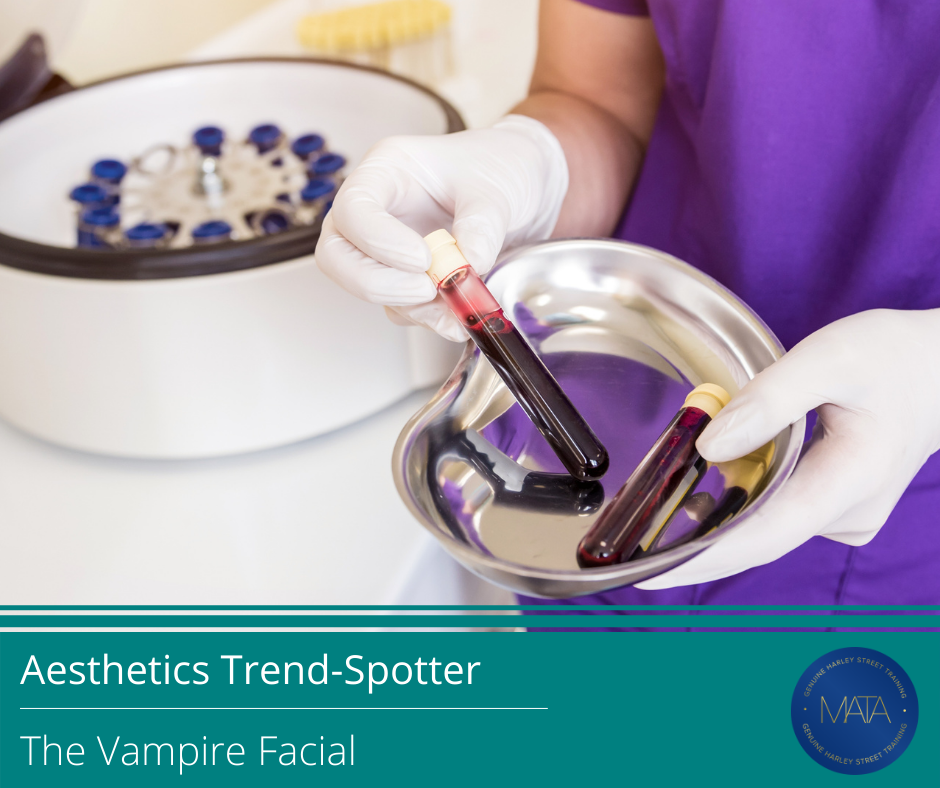
The Vampire Facial has grown hugely in popularity since Kim Kardashian’s 2013 grisly photo of herself midway through treatment, with over 232 thousand mentions on Instagram and 37.6 million views on TikTok. The treatment combines microneedling with platelet-rich plasma derived from the clients’ own blood; and it’s been claimed that the procedure can give a youthful appearance that rivals that created by injectables like Botox or filler.
How Is The Treatment Performed?
Step One – The Blood Draw: The blood is usually drawn from the arm, then placed into a centrifuge and spun to separate the red blood cells and the platelet-poor plasma from the Platelet-Rich Plasma.
Step Two – Facial Cleansing and Numbing: The clients’ face is cleansed and a numbing cream is applied to lessen the pain from the microneedling process.
Step Three – Preparation: The Platelet-Rich Plasma is drawn into a needleless syringe for ease of applying small quantities to the clients’ skin during the facial, and the microneedling device is prepared for use.
Step Four – The Facial: The Platelet-Rich Plasma is smoothed onto sections of the face, followed by the microneedling device. The microneedles push the plasma deep into the epidermis, alongside creating tiny controlled injuries to the epidermis that trigger skin healing and stimulates collagen production.
Downtime From the Vampire Facial
Although the Vampire Facial is ‘non-invasive’, this isn’t necessarily a treatment that clients can fit into their lunch break. It can cause swelling and redness for up to twelve hours following the procedure due to the microneedling process, so clients may prefer to make this an after-work treat.
Results From the Treatment
There isn’t a massive body of research on Vampire Facials. Still, practitioners and clients have reported that after a course of three treatments; the appearance of fine lines, acne scarring and skin roughness are much improved. The results from a course of Vampire Facials should last a client up to 12 months.
Risks of the Vampire Facial
Microneedling alone presents some risk to clients. Bacterial infections can occur if the skin or the machine is not cleansed properly. Clients with darker skin tones are also at risk of Post-Inflammatory Hyperpigmentation (PIH), which leaves darker patches of skin in the treated areas.
When blood is added to the microneedling procedure; other, scarier risks come into play. Two clients at a New Mexico salon in the USA contracted HIV after having Vampire Facials, potentially as a result of cross-contamination. Although this may be an isolated case, it is still something that clients should be aware of before undergoing the treatment.
At MATA, we see non-ablative laser treatment as a safe alternative to the Vampire Facial, improving the appearance of fine lines, scarring and skin texture without breaking the skin or requiring blood handling. To register your interest in our newly restructured Laser and Light qualifications, please complete this webform.
Is the Vampire Facial Here to Stay?
Although the Vampire Facial may have become popular due to a celebrity endorsement, almost ten years on it is still a favourite; available in clinics across the UK and the world. As such, it would seem like the procedure is here to stay. As always, we recommend that clients are made fully aware of the risks and rewards of the treatment. In the case of this particular treatment, we’d also recommend that the procedure takes place in a suitable setting and is carried out by a practitioner with experience in the safe handling of blood products.
Patient-First Care: Managing Client Expectations in Aesthetics

In a world filled with filters, Facetune and PhotoShop; it’s becoming more and more likely that clients may visit your clinic with unrealistic expectations of what can be achieved with Botox and dermal fillers. As a responsible aesthetic practitioner, you have a duty to ensure your patients understand whether the results they have in mind are possible and to adjust this to a more realistic level if needed. It can be difficult to know how to accomplish this, so to help, here are MATA’s top five tips for managing client expectations in aesthetics.
1. Maintain An Honesty Policy
Although of course having a book filled with clients is an admirable goal, there is no substitute for having and keeping a reputation of safe, responsible aesthetics practice. If a client comes to you with an impossible request, then be confident in your ability to tell your client exactly what you as a practitioner can achieve with aesthetic injectables, and refrain from overselling what you or the product can do. Even the best practitioner has limits, and it will only benefit your clinic to make sure your clients understand this.
2. Have a Real Conversation with Your Clients
Although consent forms are a legal necessity for your clinic, they should never take the place of a real conversation with your clients which covers the risks and rewards of their chosen aesthetic treatment. This conversation will not only allow you to identify any unrealistic expectations and manage them appropriately, but will also ensure that your clients commit to the procedure from a fully informed position.
3. Make Use of Visual Aids
It’s likely that you already have a stock of before and after photos from your existing clients to allow you to provide treatment continuity. If you have the necessary permissions to use these images for business purposes, then these before and after shots can give prospective clients a real look at the changes that are possible with aesthetic injectables.
Having a Lookbook of before and after images covering a variety of treatments will also help illustrate that some looks take time and multiple visits to accomplish. Clients may visit you with the expectation that lips can go from thin to Jenner-style voluptuous in a single treatment. Being able to show them that this isn’t possible, with reference to real cases, will often make your client far more receptive to building a treatment plan with you.
4. Be Aware of Apps, Influencers and Advertisers
With the rise of apps that allow the face and body to be heavily filtered and reshaped, even in video; influencers and advertisers have been in the spotlight for promoting looks that are unrealistic or even physically impossible. Maintaining a professional awareness of image-editing apps, the effects they can create, and even having a bank of unedited vs edited images available, can all help you manage client expectations in your aesthetics practice.
5. Feel Comfortable Saying No
It’s inevitable that during your career in aesthetics, some clients will simply not listen to your advice regarding treatment. Although it may be tempting to carry out the procedure; when the results inevitably don’t match expectations, these clients can and will cause problems for your business. In the end, it is far better to let these clients go than to lose your reputation as an aesthetics practitioner.
Aesthetic Trend Spotter: The Fox Eye Thread Lift

Gaining popularity in 2020 thanks to celebrities such as Kendall Jenner and Bella and Gigi Hadid, the Fox Eye Thread Lift has been trending on social media throughout 2021. #foxeye has over 180 thousand mentions on Instagram and 51.2m views on TikTok, both as a result of make-up styles and eyebrow shaping designed to create the elongated upwards almond shape, and thread lift aesthetic treatments, with clinics across the UK now offering this procedure.
What is the Fox Eye Thread Lift?
A Fox Eye Thread Lift allows clients to achieve a similar eye-shape to that of the Hadids without the use of make-up or eyebrow shaping. PDO or semi-permanent barbed threads are inserted at strategic points on the temple and forehead which when drawn on will hook under the skin and gently pull it back, lifting the skin around the eye up and out to create the desired upturned almond shape.
Critics of Fox Eye Thread Lifts
Like any new aesthetic treatment, this procedure has its critics. Generally, barbed thread lifts have a 15-20% complication rate, with risks including temple hematoma, thread infection, granuloma, thread snapping, suture migration, suture extrusion, and pain where the thread end meets the underside of the skin. Whilst these complications can be resolved relatively easily, both clients and aesthetic practitioners should be aware of the risk.
With the Fox Eye Lift, these risks are only increased. Normally, thread lifts are intended to create subtle improvements to lines and wrinkles, however this treatment relies on the threads creating a dramatic lift to the skin around the eye. Because of this, clients can be left with puckering and folding, as the skin has nowhere to go after being pulled up by the threads. Furthermore, as the skin around the eye can be thinner than elsewhere on the face, sutures can be visible through the skin following the procedure. Given that the dramatic effect created by the Fox Eye Thread Lift may only last three weeks, whether the results outweigh the risk of the procedure is debatable.
Beauty Meets Cultural Appropriation
In addition to the physical risks of the Fox Eye Lift, the procedure (in addition to the make-up styles and the instagram trend of pulling back the temples to create an elongated almond eye), has met with accusations of cultural appropriation and racism. Critics have commented that “a facial feature in which [asians] had once been ridiculed for was being turned into a beauty trend”, without empathy for the negative treatment many Asian people have experienced due to their eye shape.
The Future of the Fox Eye Thread Lift
It’s always difficult to tell whether certain aesthetic trends will stand the test of time. For now though, as clients from a range of age groups strive to emulate the look of models such as the Hadids, the Jenners and the Kardashians, the Fox Eye seems set to remain for the foreseeable future. We can only hope that clients are fully briefed on the risks and rewards of this treatment before undergoing the Fox Eye Thread Lift.

